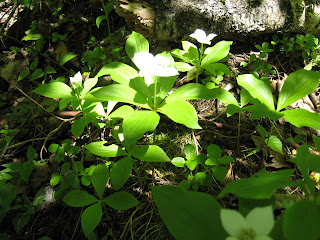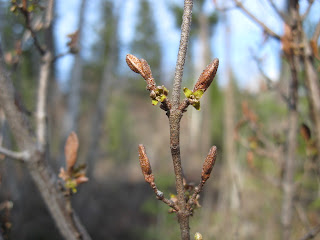 |
This is current information on which native (wild, local) plants are blooming now. See the posts below by date with the most recent just below.
These observations were taken in the Shuswap River valley at my place in Grindrod, just off the valley floor.
You might be able to find these plants close to where you live and see the blossoms first-hand. It is spring and plants are getting ready for a new season of reproduction.
June 6 - Red -orange is the colour of ...
Scarlet trumpet honeysuckle (lonicera ciliosa)
June 5 – More new blossoms today! Lots of colours plus the lovely sweet scent of wild roses.
Here are today’s colours and plants.
Blue...
Blue...
lupines (lupinus sericeus)
Yellow-orange ...
tiger lily (lilium columbianum)
purple peavine (lathyrus nevadensis) or is it american vetch (vicia americana
Pink...
rose: nootka rose (rosa nutkana) or prickly rose (rosa articularis)
and the baldhip rose (rosa gymnocarpa) - photo coming later
White...

thimbleberry ( rubus parviflorus) photo later
bunchberry (cornus canadensis)
creamy peavine (lathyrus ochroleucus)
red elderberry - note cone-shaped blossom

Still blooming...
false solomon’s seal - a sea of blossoms and lovely scent
queen’s cup,
redstem ceanothus (ceanothus sanguineus),
arnica (making seed)
Plants setting seed...
red twinberry (lonicera utahensis)
Red twinberry with twin berry
The first queen's cup is out! in a sheltered place near the creek.
May 22
WHITE, YELLOW AND BLUE are the spring colours of blossoms in the Shuswap today. All these are blooming today!
- saskatoons (amelanchier alnifolia)
- wild strawberry (fragaria vesca and fragaria virginiana)
- false solomon’s seal (smilacina racemosa)
- oregon grape (mahonia aquifolium)
- heart leaved arnica (arnica cordifolia)
- last of the red twinberry (lonicera utahensis)
- fairy bells (disporum hookeri and disporum trachycarpum)
- blue clematis (clematis columbiana)
The Saskatoons (amelanchier alnifolia) are a mass of white blossoms. Their falling petals look like late snow on the ground.
Each wild strawberry has one or more small bright white blossoms, the blue leaf variety (fragaria virginiana) hugging close to the ground. The wood strawberry (fragaria vesca) likes a little more shade and moisture and its blossoms are on stalks that grow longer than the leaves are and thus easier to pick when the time comes (if you can survive the mosquitoes then).
The false solomon’s seal (smilacina racemosa) blossoms are a combination of white and yellow right now, with the white parts fully open and the yellow the unopened promise to come. These gorgeous scented plants with their main stalk and long pointed green leaves are the ones I wait for all year. The air is filled with their scent as I walk along the creek trail. They like some shade (usually) and moisture. When mature the berries are sweet red treats.
The oregon grape (mahonia aquifolium) is in full bloom with clusters of yellow blossoms at the end of the branches of green spikey leaves. There is a nice, mild scent. Some of the blossoms are already dropping their petals and have the beginnings of the blue berries that will follow.
Bright yellow daisy like heads are the heart leaved arnica (arnica cordifolia) blossoms with their “green” scented leaves covering the ground. They grow in nice patches as they generally spread by rhizomes. I gently squeeze the leaf between my fingers and then inhale the refreshing scent, leaving the plant intact and never harming it by picking. There is no need. It is there again for me to smell on my next walk.
The last of the red twinberry (lonicera utahensis) blossoms are on a plant in a cool shaded location. The wonderful scent of these is the first, best smell of spring. I inhale deeply with a chest breath to get the full aroma of this lovely little pale yellow/white bell.
Hookers fairy bells are in full bloom...
The lovely white fairy bells (disporum hookeri) are at knee height (or more) and easy to miss as you are walking. Their delicate double bells hang down hidden by their long green leaves. I think the resulting red/yellowish berries look like jelly beans, seemingly almost translucent and smooth. The other fairy bell, rough fruited (disporum trachycarpum), has a squarish red almost furry texture berry to my way of seeing. Their leaves are more blunted and deeper green and there are fewer plants in my area so always a treat to see.
And then there is the blue surprise. This wild clematis (clematis columbiana) is a delicate, short lasting vine. I had lived here for years but never seen it – going too fast, looking the wrong way. What a surprise to see blue in the forest when all was usually white and green.
April 15 - The first red twinberry (lonicera utahensis) blossoms are opening - the first two tiny bells on the plant. These blossoms haven't developed their lovely fragrant scent yet. This plant is in a sheltered location and blossoms on plants in other areas are not out yet. The scent of these blossoms are my favourite and so early plus this is the first plant to leaf out and blossom at the same time - wild flowers in April!!
April 9 - Hazelnut (corylus cornuta) and soapberry (shepherdia canadensis) are blooming now!
This photo, taken 3 weeks after first sighting, shows the feathery petals against the sky.
The magenta coloured feathery petals of the hazelnut look like a wispy paint brush. You need to look carefully and closely to see this delightful bright colour in the greyish woods. Hazelnut grows in moist areas and is close to the creek on my place. Soon the catkins will produce their yellow powder to pollinate the buds and make small wild berries that the squirrels take.
Also in miniature size, are the bright yellow blossoms of the soapberry plant. I noticed a hoard of bugs around this plant. I wonder if there is something attracting them - maybe a scent that I cannot smell on the little square blossoms. You have to look closely to see them. Only the blossoms are out, not the leaves that are still clasped together in pairs.
What is blooming in your area and where do you live? You are welcome to make a comment below.


























